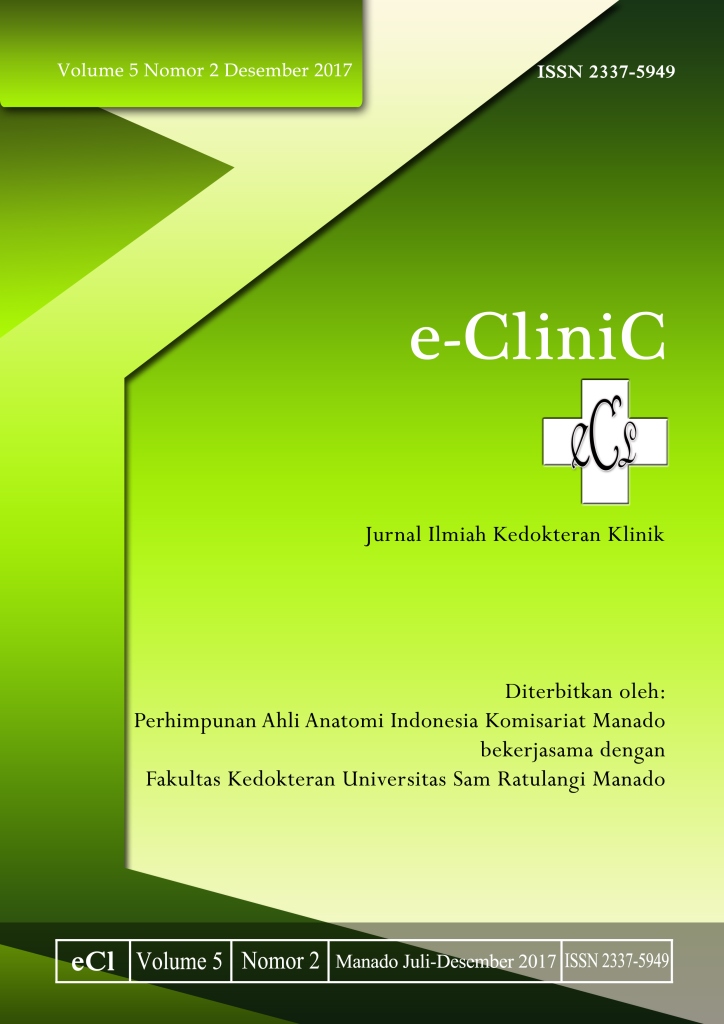Gambaran Faktor Risiko Penderita Osteoartritis Lutut di Instalasi Rehabilitasi Medik RSUP Prof. Dr. R. D. Kandou Manado Periode Januari –Juni 2017
DOI:
https://doi.org/10.35790/ecl.v5i2.18540Abstract
Abstract: Osteoarthritis (OA) is a chronically progressive degenerative joint disease associated with joint cartilage damage. It is usually affected the joints of the hands, vertebrae, hips, and knee which is reported as the most common affected location. Risk factors of OA are divided into non-modifiable factors and modifiable factors. The non-modifiable risk factors are age, gender, race, and genetic factors, while the modifiable factors are body mass index, occupation, knee injury, blood pressure, blood sugar level, and cholesterol level. This study was aimed to determine the non-modifiable risk factors and modifiable risk factors in patients with knee OA at the Medical Rehabillitation Unit of Prof. Dr. R. D. Kandou Hospital Manado. This was a quantitative descriptive study using medical record data in the Medical Rehabilitation Unit. There were 36 cases of knee OA during the period of January-June 2017; 27 cases had complete medical record data. The highest distribution of knee OA were patients in the 70-79 age group (33.3%), females (70.4), Minahasa ethnic (59.3%), no family history of OA (70.4%), BMI ≥23 (66.7%), retired (51.9%), history of knee injury (77.8%), prehypertension (51.9%), no history of DM (70.4%) and of hypercholesterolemia (66.7%). Conclusion: Based on the non-modifiable risk factors, females were more at risk of developing knee OA and based on modifiable risk factors, knee injury was the most common factor in the occurrence of knee OA.
Keywords: knee osteoarthritis, risk factors
Â
Abstrak: Osteoartritis (OA) merupakan penyakit sendi degeneratif yang berkaitan dengan kerusakan kartilago sendi dan bersifat kronik-progresif. Lokasi yang biasanya terkena adalah sendi pada tangan, vertebra, panggul dan lutut, dimana lutut dilaporkan sebagai lokasi yang paling sering terkena. Faktor risiko OA terbagi atas faktor yang dapat di modifikasi dan faktor yang tidak dapat di modifikasi. Faktor risiko yang tidak dapat dimodifikasi ialah antara lain umur, jenis kelamin, suku/ras dan genetik. Faktor risiko yang dapat dimodifkasi berupa indeks massa tubuh, pekerjaan, cedera/trauma, tekanan darah, gua darah, dan kadar kolesterol dalam darah. Penelitian ini bertujuan untuk mengetahui faktor risiko yang tidak dapat dimodifikasi maupun dapat dimodifikasi pada penderita OA lutut di Instalasi Rehabilitasi Medik RSUP Prof. Dr.R. D. Kandou Manado. Jenis penelitian ialah deskriptif kuantitatif menggunakan data rekam medik di Instalasi Rehabilitasi Medik. Terdapat 36 kasus OA lutut selama periode Januari-Juni 2017; hanya 27 kasus yang memiliki data rekan medik lengkap. Pada penelitian didapatkan distribusi OA lutut terbanyak pada kelompok usia 70-79 tahun (33,3%), jenis kelaimin perempuan (70,4%), suku Minahasa (59,3%), tidak memiliki riwayat OA dalam keluarga (70,4%), IMT ≥23 (66,7%), pensiunan (51,9%), riwayat cedera lutut (77,8%), tekanan darah pre-hipertensi (51,9%), tanpa riwayat DM (70,4%) dan riwayat hiperkolesterolemia (66,7%). Simpulan : Berdasarkan distribusi faktor risiko yang tidak dapat dimodifikasi, jenis kelamin perempuan paling rentan terhadap OA lutut dan berdasarkan faktor risiko yang dapat dimodifikasi, cedera/trauma lutut merupakan faktor yang paling sering.
Kata kunci: osteoatritis lutut, faktor risiko
Downloads
How to Cite
Issue
Section
License
COPYRIGHT
Authors who publish with this journal agree to the following terms:
Authors hold their copyright and grant this journal the privilege of first publication, with the work simultaneously licensed under a Creative Commons Attribution License that permits others to impart the work with an acknowledgment of the work's origin and initial publication by this journal.
Authors can enter into separate or additional contractual arrangements for the non-exclusive distribution of the journal's published version of the work (for example, post it to an institutional repository or publish it in a book), with an acknowledgment of its underlying publication in this journal.
Authors are permitted and encouraged to post their work online (for example, in institutional repositories or on their website) as it can lead to productive exchanges, as well as earlier and greater citation of the published work (See The Effect of Open Access).







